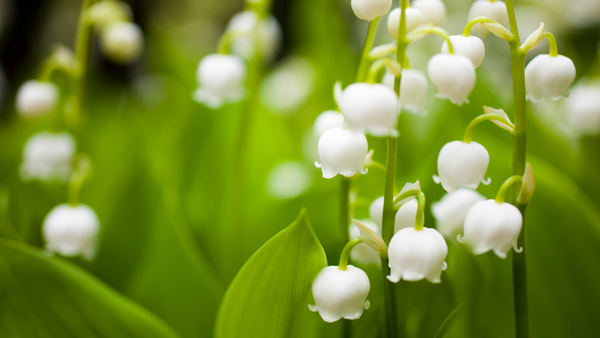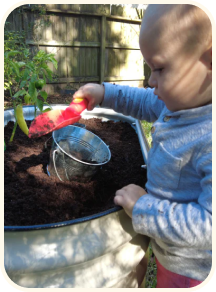10 Poisonous Flowers to Avoid in the Garden
In the plant world, poisonous flowers aren’t always apparent – some of the most delicate ones are among the deadliest. Often disguised among the bright blooms and shiny foliage as innocuous garden guests, these plants contain poisons and neurotoxins that could paralyze and kill if wrongly handled, some figuring as deadly poisons in folklore. When certain parts of these flowers are ingested, even in small quantities, it can lead to unpleasant or even fatal side effects. If you are accident prone or live with young kids or pets, then it’s best to become informed before deciding whether to grow them or avoid them altogether. Though many have been used in traditional medicine to treat ailments, their efficacy has not been supported by substantial scientific evidence, and extreme caution should be exercised. Below are ten flowers to watch out for on your property.
Monkshood
A stately plant laden with striking spires of indigo blossoms, monkshood bears some resemblance to larkspur, another poisonous plant. Alternate names, including wolf’s bane and the queen of poisons, all point to its poisonous nature. Monkshood contains aconitine, a deadly poison found in all parts of the plant, especially the roots. The tubers of the aconite plant have traditionally been used in Eastern medicine as herbal remedies. When carefully prepared, the process negates the harmful effects, turning it into a fairly effective non-inflammatory medication. However, if improperly treated, the effects can be fatal. When dealing with monkshood, always wear garden gloves, which can be easily stored in a versatile garden bag.

Deadly Nightshade (Belladona)
The berries of the Belladona plant were used during the Middle Ages for cosmetic purposes. Though belladonna means ‘beautiful lady’ in Italian, its glamorous name hides a darker side – it has long been used by assassins for centuries and allegedly by the Romans to make poison-tipped arrows. The black berries of deadly nightshade are highly poisonous, particularly to children. If ingested, it will paralyze gastrointestinal muscles, leading to dilated pupils, hallucinations, and death by respiratory failure. Despite its dark history, the chemicals derived from deadly nightshade, atropine and scopolamine, have been used in medicine to dilate pupils and treat stomach ulcers and motion sickness. Unless it has been prescribed by a reputable doctor, you should not take belladonna on your own.
Lily of the Valley
Lily of the valley is a whimsical plant with dainty, bell-shaped flowers that produce a sweet scent during spring. A symbol of resurrection and humility, it has been associated with the tears Mary shed after Jesus’s crucifixion. Despite its beauty, it is highly toxic; its flowers, berries, and foliage contain cardiac glycosides that will cause blurry vision, headaches, and irregular heartbeat if accidentally consumed. Preferring partial shade and moist sure, lily of the valley is popular as a ground cover.

Oleander
Oleander is a delicate plant native to the Mediterranean region, where it is used as highway barriers to prevent erosion. With flowers ranging from pink to burgundy, it is a popular decorative element in gardens. Highly toxic when ingested, even in relatively small amounts, its foliage can induce skin irritation just by brushing against it. In traditional medicine oleander has been used to treat a wide range of maladies such as indigestion, asthma, epilepsy, and even cancer, though it is no longer considered safe to use due to high toxicity levels.
Rhododendrons and Azalea
Though rhododendrons and azaleas may seem fairly harmless, they pose moderate to severe toxicity to dogs and cats – just the ingestion of a few leaves can be dangerous. Closely related to rhododendrons, azaleas are a flowering shrub in the rhododendron genus. In small amounts, they are not considered life-threatening, but consumption of its honey can result in unpleasant, hallucinogenic side effects, including intense hallucinations, blurred vision, and convulsions. Known as ‘mad honey,’ the term comes from honey extracted from the nectar of rhododendrons. Several historical accounts indicate that mad honey has been used by Turkish royalty to sedate invading Roman armies, leaving them vulnerable to attack. While not as deadly as some of the other plants on the list, they should still be carefully monitored.
Water Hemlock
Water hemlock is a highly poisonous wetland plant commonly found along marshland and banks of streams, pools, and rivers. Considered the most poisonous plant in America, it contains toxic alkaloids that cause violent convulsions and seizures, sometimes taking as little as 15 minutes to take effect. Accidental ingestion of water hemlock is most often attributed to misidentification. Even brushing up against water hemlock can cause skin irritation. Quite similar to Queen Anne’s Lace, a harmless flower, it is important to identify the differences between the two. The stems of Queen Anne’s Lace are covered with hairs, while the stems of water hemlock are smooth and have splotches of purple.

Hydrangea
Known for their showy displays of cotton-candy flowers, hydrangeas are poisonous to pets, but they must be consumed in very large quantities for it to lead to toxicity symptoms. All parts of the hydrangea plant contain amygdalin, a substance that when broken down, produces cyanide. Interestingly, smoking some varieties can lead to dizziness, heart rate increase, and feelings of getting high, with overconsumption leading to stomach and respiratory problems. As most people have the common sense not to smoke dried hydrangea leaves or flowers, they are not considered a dangerous threat.
Foxglove
Foxglove is an enchanting, ephemeral flower often seen adorning informal or English garden paths, adding a quaint romanticism to places bereft of color. Despite its beauty, it contains poisons that can inflict treacherous harm. Poisonous to the touch, its toxins can be absorbed through the skin and cause an allergic reaction. All parts of the plant contain digitalis and other cardiac glycosides that can disrupt the heart when ingested. While foxglove has been used for medicine, self-medication is heavily discouraged. Foxgloves are a naturalized species that thrives in slightly acidic soil in partial shade. In some places, it is considered an invasive or weed species.
Castor Oil Plant (Castor Bean)
The castor oil plant is an intriguing plant featuring dark, lobed foliage with a reddish tinge and spiky red flowers. The seeds of the castor oil plant contain ricin, one of the most poisonous substances in the world. While ricin has been used in experimental medicine to treat cancer, it mostly commonly figures in popular culture as a poisonous biological agent of which there is no antidote. It can be potentially made into a powder, mist, or pellet, and disseminated through food, air, or water. One milligram of ricin in food or water can kill an adult.

Manchineel Tree
Labeled as the Tree of Death, the manchineel tree bears sweet scented fruit resembling stunted apples, though taking a bite can prove fatal. An endangered species native to the brackish coastal waters of Florida, it is considered the most dangerous tree in the world. When it is raining, the milky sap of the manchineel tree leeches down, resulting in scalding skin irritations to any unlucky bystander. Simple contact with any part of the tree can cause breathing problems or even temporary blindness. The Spanish explorer Juan Ponce de León was allegedly killed by an arrow tipped with its poisonous sap.





























Thanks for the info. Please do not rent or sell my email address
Leave a comment